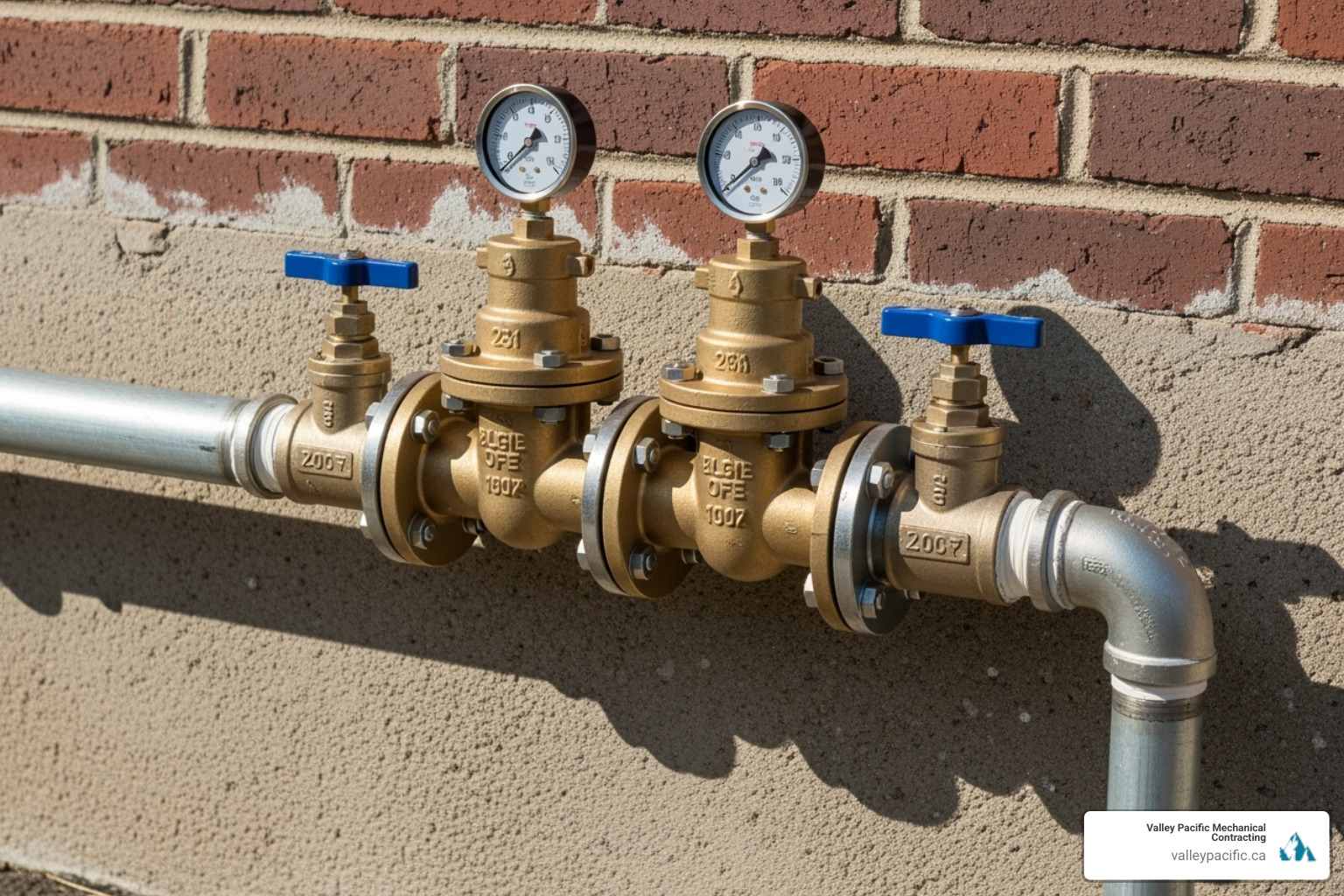The Unseen Guardian: Why Backflow Prevention Testing is Crucial for Your Home


Why Backflow Prevention Testing Protects Your Home's Water Supply
Backflow prevention testing is a mandatory annual inspection that ensures devices protecting your water supply from contamination are working properly. Here's what you need to know:
Key Testing Requirements:
- Annual testing required by municipal codes
- Certified tester must perform the inspection
- Property owners are responsible for scheduling and paying for tests
- Failed devices must be repaired immediately and re-tested
- Test reports must be submitted to your local water authority
- Non-compliance can result in fines or water service disconnection
Most homeowners don't think about their water supply until something goes wrong. But hidden within your plumbing system, specialized devices work around the clock to prevent contaminated water from flowing backward into your clean drinking water.
Backflow occurs when water flows in the wrong direction - bringing fertilizers from your sprinkler system, chemicals from your boiler, or other contaminants directly into the water you drink and cook with. In 2005, a car wash substance contaminated the water supply for 30,000 residents in Stratford, Ontario - an incident that could have been prevented with properly functioning backflow prevention devices.
These mechanical devices contain springs, seals, and moving parts that can wear out, get clogged with debris, or be accidentally bypassed. That's why testing is legally required - typically once per year - to verify they're still protecting your family and your community.
The testing process is straightforward but must be done by a certified professional. They'll connect specialized gauges to your device, monitor pressure changes, and provide you with official documentation for your municipal water authority.
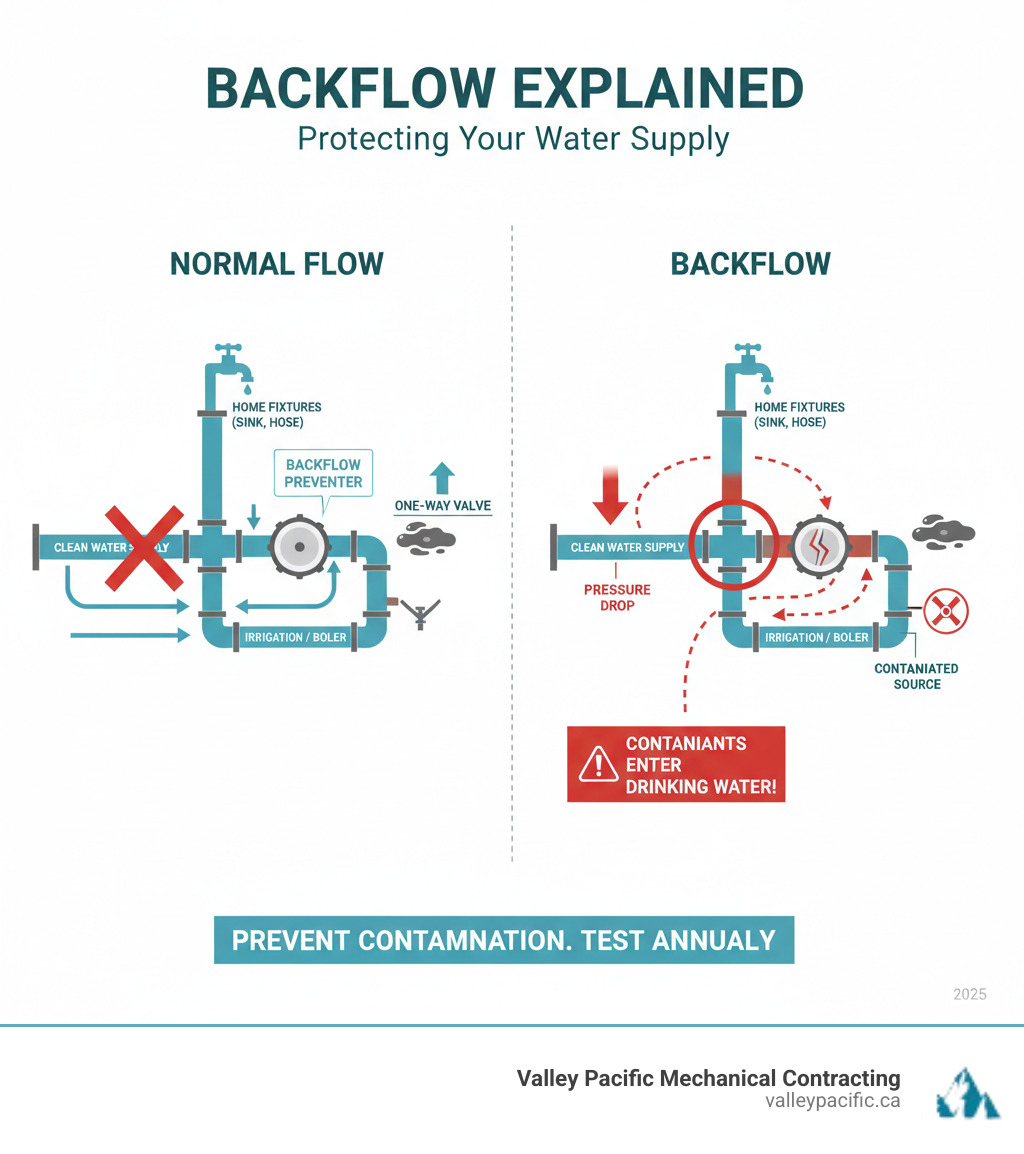
Know your backflow prevention testing terms:
Understanding Backflow: A Threat to Your Water Supply
Picture this: you turn on your kitchen tap expecting fresh, clean water, but instead get a nasty surprise. While this scenario might sound like something out of a horror movie, it's exactly what can happen when backflow occurs in your home's plumbing system.
Backflow is simply water flowing in the wrong direction – instead of clean municipal water flowing into your home, contaminated water from your property flows backward into the public water supply or other clean water lines in your house. Think of it like a river suddenly reversing course and flowing uphill.
This reverse flow becomes dangerous when there's what experts call a cross-connection – any physical link between your drinkable water supply and a non-drinkable source. Your garden hose sitting in a bucket of fertilizer water is a perfect example. Under the right conditions, that contaminated water can get sucked right back into your drinking water system.
The health risks are no joke. Contaminants can include pesticides from your sprinkler system, chemicals from industrial processes, human waste from sewer lines, or bacteria and viruses that can make your entire family sick. In some cases, entire communities have been affected when backflow contaminated the public water system.
That's why protecting potable water safety isn't just about your household – it's about being a good neighbor and protecting everyone's health. For more detailed information on cross-connection control, the EPA provides an in-depth guide that covers all the technical details.
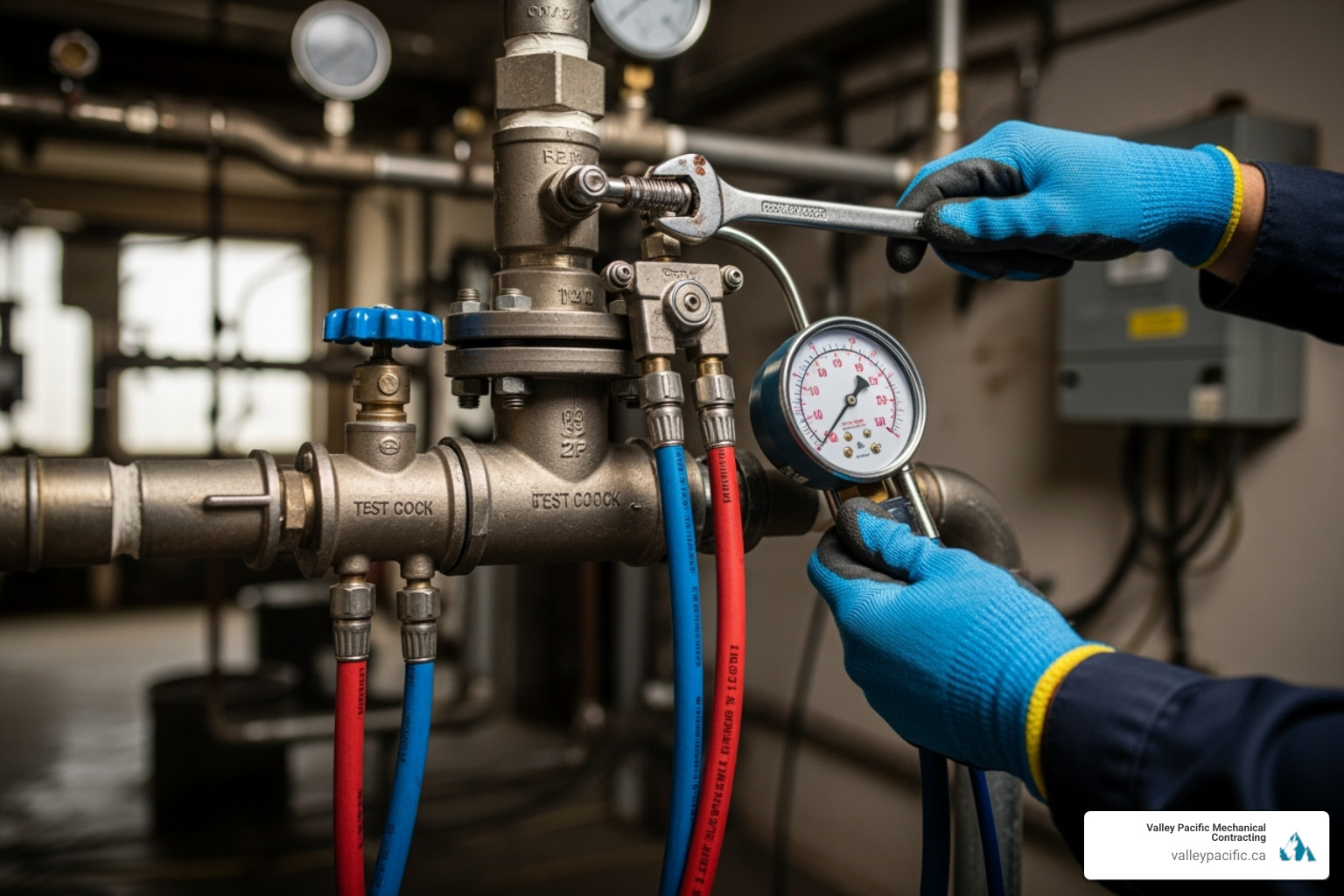
The Common Causes of Backflow
Backflow doesn't just happen randomly – it's usually caused by sudden changes in water pressure that create the perfect storm for contamination. There are two main culprits you should know about.
Back-siphonage happens when there's a sudden drop in pressure in your main water supply, creating a vacuum effect. It's like when you're drinking through a straw and accidentally suck too hard – whatever's at the other end comes rushing up. Water main breaks are a common cause, as they can drastically reduce pressure in nearby lines. Firefighting operations also create this problem when fire hydrants draw massive amounts of water quickly, causing negative pressure in the system.
Back-pressure works the opposite way – it occurs when the pressure inside your home's plumbing becomes higher than the pressure from the municipal supply. Instead of being sucked backward, contaminated water gets pushed into your clean water lines.
Boiler systems are frequent offenders here, especially when they have malfunctioning pressure relief valves or issues with thermal expansion. When water heats up, it expands, and in a closed system, this can create serious pressure buildup. Lift piping – water lines that go to higher elevations in your home – can also create enough pressure to cause problems.
The good news? Understanding these pressure changes helps explain why backflow prevention testing is so important for keeping your water safe. For more information about preventing various water system failures in your home, check out our guide on preventing water system failures.
The Role of Backflow Prevention Devices
Think of backflow prevention devices as the unsung heroes of your plumbing system. These specialized guardians work silently behind the scenes, making sure water only flows in the right direction – away from contamination sources and toward your clean drinking water.
The most effective approach is called premise isolation. This means installing a backflow prevention device right at your property's main water connection. It's like having a security checkpoint that protects the entire public water supply from anything that might go wrong on your property.
But not all properties face the same risks. That's why these devices are selected based on hazard levels – essentially how dangerous the potential contamination could be.
Minor hazard situations might just affect how your water tastes or looks, but won't make you sick. Think of a cross-connection that could add harmless minerals to your water supply.
Moderate hazard involves substances that could cause minor health issues or be a nuisance, but aren't likely to seriously harm anyone. This might include certain non-toxic chemicals or additives.
Severe hazard is the big concern – any contamination that could seriously threaten public health. This includes industrial facilities, hospitals, dental offices, car washes, and properties with chemical fire suppression systems. Even your home's irrigation system falls into this category because of fertilizers and pesticides.
The goal is system protection that matches the risk level. A minor hazard doesn't need the same heavy-duty protection as a severe one. Getting this match right is crucial for keeping everyone's water safe.
Our experienced team at Valley Pacific Mechanical understands these requirements inside and out. We provide expert guidance and professional installation as part of our comprehensive Plumbing Services in Maple Ridge BC.
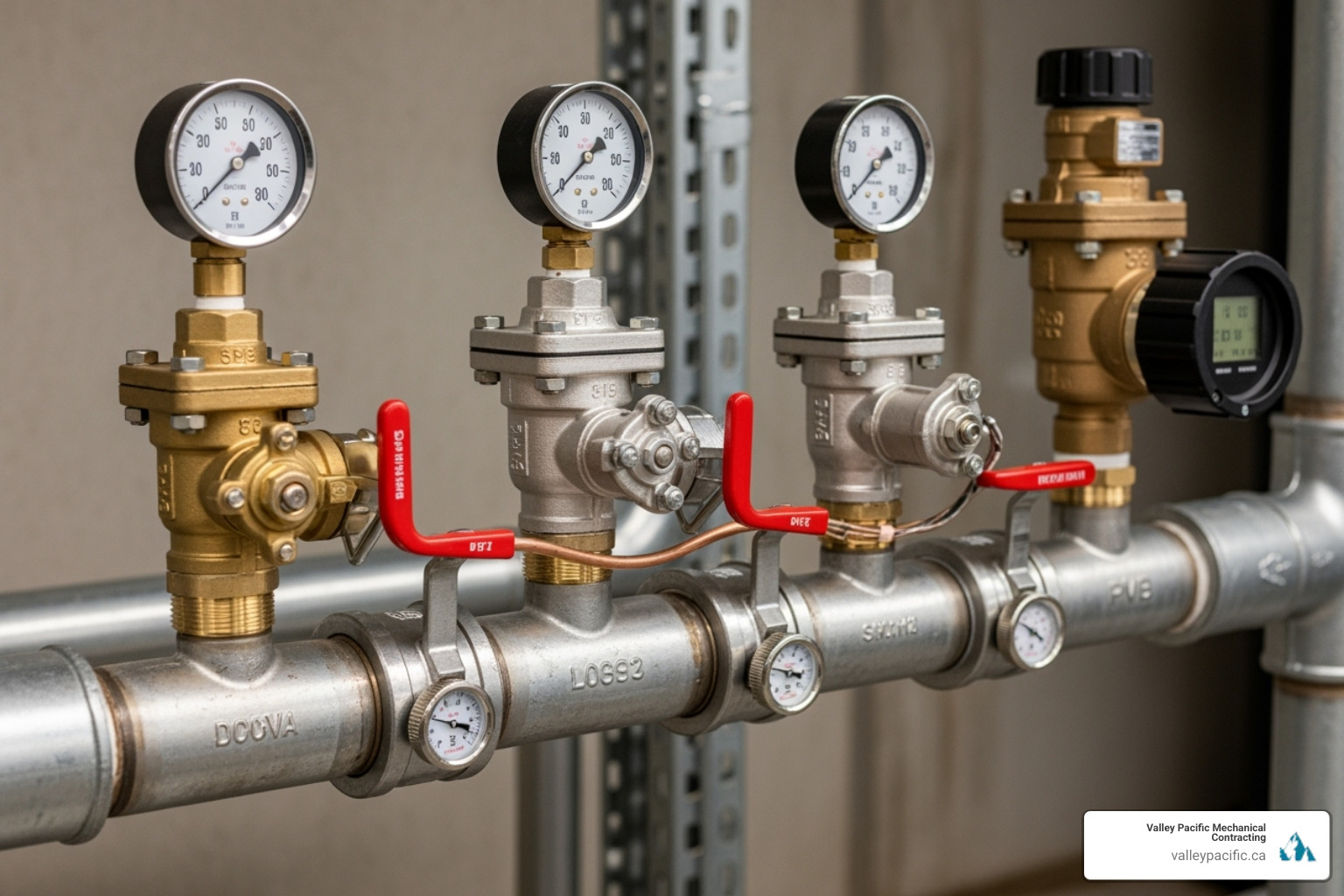
Types of Backflow Preventers
When it comes to choosing the right backflow preventer, it's all about matching the device to your specific needs. Each type has its strengths and is designed for particular situations.
The Reduced Pressure Principle Assembly (RP) is like the premium security system of backflow prevention. This robust device features two independent check valves with an automatic pressure relief valve sitting between them, plus shut-off valves on both ends. If either check valve fails, that relief valve immediately opens and dumps water to the ground – a clear sign something's wrong. RPs are required for severe hazard applications because they're incredibly reliable and can handle the toughest conditions.
The Double Check Valve Assembly (DCVA) is the workhorse for moderate hazard situations. It has two independent check valves and shut-off valves, but no relief valve. This makes it effective against both back-pressure and back-siphonage, though it can't handle extreme pressure situations like an RP can. It's a solid choice when the contamination risk isn't life-threatening.
Pressure Vacuum Breakers (PVB) are commonly seen on sprinkler systems and are specifically designed to prevent back-siphonage. They have a spring-loaded check valve and an air inlet valve that opens when pressure drops, breaking any vacuum that could suck contaminated water backward. However, PVBs aren't suitable when there's risk of back-pressure or when the device needs to be under constant pressure.
The Air Gap is beautifully simple – it's literally an open space between your water supply pipe and any potential contamination source. Picture the gap between your kitchen faucet and the sink rim. Since there's no physical connection, backflow is impossible. Air gaps need no testing and never fail, but they're not practical for every application.
Proper device selection isn't guesswork – it's determined by local plumbing codes, your specific application, and the assessed hazard level. That's why backflow prevention testing by certified professionals is so important to ensure these devices continue protecting your water supply year after year.
The Essentials of Backflow Prevention Testing
Think of your backflow prevention device like the brakes on your car. You trust them to work when you need them, but would you drive for years without having them checked? That's essentially what happens when property owners skip their backflow prevention testing.
These mechanical devices work hard behind the scenes, but they're not invincible. Springs lose their tension, seals crack over time, and debris can sneak in and jam up the works. What looks fine from the outside might be completely compromised on the inside.
Regulatory compliance isn't just red tape – it's a lifeline for our community's water supply. Municipal by-laws across the Lower Mainland mandate regular testing because water quality protection is serious business. The public health mandate behind these rules comes from real-world disasters where contaminated water made entire communities sick.
The consequences of non-compliance can hit you where it hurts. We're talking about hefty fines that can run into thousands of dollars. Even worse? Your municipality can order a complete water supply shut-off until you get compliant. Imagine explaining to your family why there's no water for showers, cooking, or even flushing toilets – all because of a skipped test.
For property owners who want to understand their obligations better, Ontario provides A guide to backflow prevention programs that breaks down the requirements clearly.
Why is Backflow Prevention Testing Necessary?
Here's the reality: device failure happens more often than you'd think. Those precision-engineered check valves and relief valves? They're constantly battling water pressure, temperature changes, and whatever debris comes through your pipes.
Worn parts are inevitable. Seals deteriorate, springs weaken, and moving components can stick or break entirely. Debris fouling is another silent killer – a small piece of rust or sediment can prevent a valve from closing properly, leaving your water supply vulnerable.
The annual requirement isn't arbitrary. It's based on decades of research showing that mechanical devices need regular check-ups to keep functioning reliably. Ensuring proper function through testing catches problems before they become disasters.
But beyond the mechanics, there's a bigger picture. This is your legal obligation as a property owner, and it's about protecting community water for everyone. When your device fails, it's not just your family at risk – it's your entire neighborhood's water supply that could become contaminated.
Think of backflow prevention testing as insurance for your peace of mind. It's a small annual investment that protects something irreplaceable – the safety of the water you and your community depend on every day.
The Backflow Testing Process: What to Expect
When it's time for your annual backflow prevention testing, you might be wondering what exactly happens during this process. Don't worry – it's more straightforward than you might think, and our certified technicians at Valley Pacific Mechanical handle everything to give you that headache-free experience we're known for.
The first thing to know is that this isn't a job you can tackle yourself. Certified testers are required by law, and they need specialized training and equipment to perform these tests properly. We've invested in the proper certification and professional-grade test kits to ensure your testing meets all municipal and provincial standards throughout the Lower Mainland.
Here's what you can expect when we arrive at your property. Our technician will start by locating your backflow prevention device – it's usually installed near your water meter or at specific cross-connection points like where your irrigation system connects. Once we've found it, we'll connect our specialized test kit equipped with pressure gauges to the device's test cocks. These gauges let us measure the pressure differentials across all the internal components of your backflow preventer.
The actual testing involves systematically opening and closing valves while monitoring those gauges. We're checking to make sure the check valves and relief valve (if your device has one) are holding pressure and operating exactly as the manufacturer intended. Think of it like giving your device a thorough physical exam – we're making sure every part is doing its job to prevent backflow effectively.
Now, here's the part that catches some homeowners off guard: we'll need to temporarily shut off your water during the test. But before you panic about being without water all day, know that this usually only takes about 30 minutes. We work efficiently to minimize any disruption to your daily routine, and since we don't drain the system, there's no waiting around for lines to refill afterward.
Once the test is complete, we handle all the documentation for you. We'll fill out the official Test & Maintenance Report that records whether your device passed or failed and notes any repairs that might be needed. This paperwork is crucial for regulatory compliance, and we'll submit it directly to your local water authority – no extra work for you.
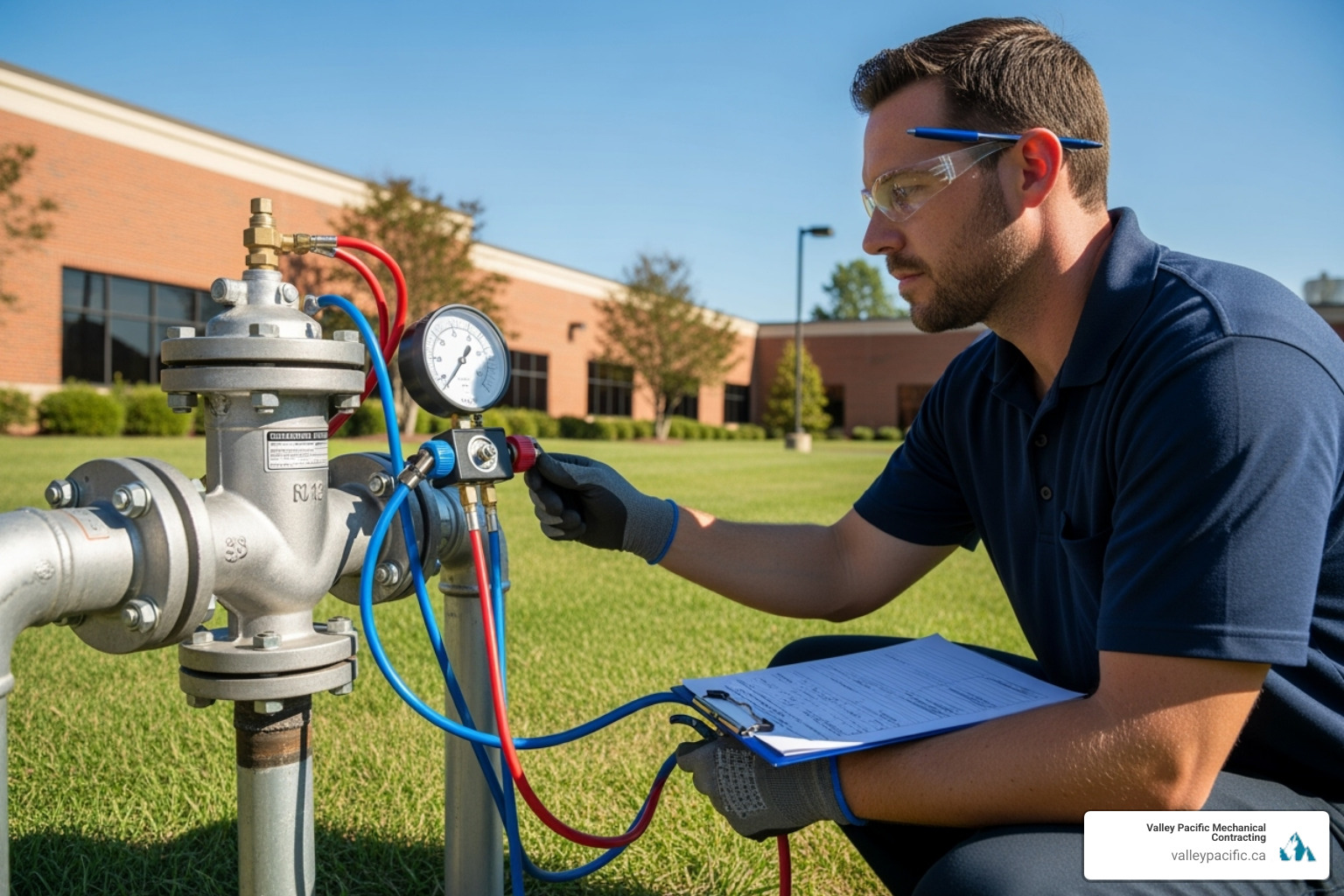
How often is backflow prevention testing required?
The simple answer is annually – most municipal codes and water authorities throughout the Lower Mainland require backflow prevention testing once every year. But that's not the only time your device needs attention.
Upon installation of any new backflow prevention device, testing is mandatory. This ensures your device was installed correctly and is protecting your water supply from day one. Similarly, after repairs or maintenance work, your device must be re-tested to verify everything is working properly again.
If your device ever needs to be moved or relocated for any reason, that triggers another testing requirement. Manufacturer instructions also play a role – they often specify their own testing intervals that must be followed alongside municipal requirements.
The key thing to remember is that your municipal code is the final authority on testing frequency. Whether you're in Langley, Maple Ridge, Coquitlam, or anywhere else in the Lower Mainland, it's worth checking with your local water provider to confirm their specific requirements. While annual testing is the standard, some municipalities might have slightly different rules based on your property type or risk level.
Who is responsible for backflow prevention testing?
This one's crystal clear: the property owner is responsible. That means if you own the property, the buck stops with you when it comes to backflow prevention testing.
While Valley Pacific Mechanical provides the certified testers and handles the actual testing process and documentation, you as the property owner need to make sure it happens. This means hiring certified testers like us to perform the annual inspection, and ensuring that all the proper reports get submitted to your water authority.
Maintaining records is another part of your responsibility. Even though we typically handle submitting the Test & Maintenance Report directly to the water authority, you should keep copies of all test reports and maintenance records for your own files. This documentation proves you're staying compliant with local regulations.
This responsibility applies whether you own a single-family home with an irrigation system, a multi-residential building, or a commercial property. The bottom line is that protecting the community's water supply starts with individual property owners taking care of their backflow prevention devices – and that's where we come in to make the whole process as smooth as possible for you.
Frequently Asked Questions about Backflow Prevention
When it comes to backflow prevention testing, we get a lot of questions from homeowners across the Lower Mainland. Let's clear up some of the most common concerns we hear about.
Do I need a backflow preventer for my lawn irrigation system?
Yes, absolutely. This is one of the most common requirements, and for good reason. Your lawn irrigation system is what we call a high-risk cross-connection, and here's why that matters.
Think about what happens to the water sitting in your sprinkler lines. It's not moving constantly like the water in your kitchen tap. Instead, it sits there, potentially picking up fertilizers and pesticide contamination from your lawn treatments. If you've got pets or wildlife in your yard, there could be other unpleasant surprises mixed in too.
Now imagine what happens during a water main break or when the fire department is using hydrants nearby. The sudden pressure drop can create a vacuum effect, pulling all that contaminated water back through your pipes. Without a backflow preventer, those chemicals and contaminants could end up in your drinking water - or worse, in the public water supply affecting your entire neighborhood.
Most municipal codes specifically require backflow prevention devices on irrigation systems. It's not just about protecting your home's water supply; it's about being a responsible member of your community and protecting the public water system we all depend on.
What happens if my device fails the test?
Nobody likes to hear their device has failed, but it's actually better to find out during testing than to find it when contamination has already occurred. When your backflow preventer fails its test, here's what needs to happen next.
First, don't panic. The certified tester will explain exactly what went wrong - maybe a check valve isn't sealing properly, or a relief valve is stuck. These are mechanical devices with moving parts, and like your car or furnace, they occasionally need attention.
Immediate repair is required - this isn't something you can put off until next month. The device needs to be fixed or replaced right away because it's no longer protecting your water supply. Our team at Valley Pacific can handle these repairs promptly, often the same day.
Once the repair is complete, re-testing is required to make sure everything is working correctly. Think of it like a follow-up appointment after medical treatment - we need to confirm the fix was successful. Only after the device passes this second test can we submit a passing report to your local water authority.
The key is acting quickly. Delays can lead to fines or even water service interruption until the problem is resolved. That's why we offer 24/7 emergency service - because protecting your water supply can't wait for regular business hours.
How do local backflow programs vary?
Here's where things get interesting - and sometimes a bit confusing. While every municipality wants to protect drinking water, they don't all go about it in exactly the same way.
Municipal by-laws vary significantly, even here in the Lower Mainland. Langley might have different requirements than Maple Ridge, and Mission could have its own unique approach. What stays consistent is the goal: keeping contaminated water out of the clean supply.
Reporting procedures can be quite different too. Some cities use online systems where test results get uploaded directly, while others prefer traditional paper submissions. The timelines for compliance, the specific forms required, and even the penalties for non-compliance can vary from one community to another.
Hazard level definitions might seem straightforward, but different municipalities can have their own interpretations of what constitutes a severe versus moderate risk. A facility that's classified one way in Coquitlam might be viewed differently in another city.
The bottom line? Check with your local water authority for the specific requirements in your area. Our technicians are familiar with regulations across all the communities we serve, so we can help guide you through your local compliance process and make sure you're meeting all the right requirements.
Don't let the variations worry you though - the fundamentals of backflow prevention testing remain the same everywhere. It's really just the paperwork and timelines that differ.
Conclusion
When you turn on your kitchen faucet tomorrow morning, clean water will flow out like it always does. But behind that simple act lies an intricate system of pipes, pressure, and protection that most of us never think about. Backflow prevention testing is one of those invisible safeguards that keeps working quietly in the background, making sure the water coming out of your tap is as pure as it should be.
Think of it this way: your backflow preventer is like a security guard for your water supply. Just like you'd want to make sure your security system is working properly, these devices need their annual check-up to ensure they're still doing their job. It's not just about following the rules – though those municipal bylaws exist for good reason. It's about protecting your water supply and knowing that every glass of water you pour is safe for your family.
The beauty of proactive maintenance is that it prevents problems before they start. A failed backflow device isn't something you want to find during an emergency. By staying on top of your testing schedule, you're buying yourself peace of mind and avoiding the headache of dealing with contaminated water or, worse yet, having your water service shut off.
As a property owner, this responsibility might feel like just another item on your to-do list. But when you consider that you're helping protect not just your own family but your entire community's water supply, it becomes something bigger. It's about being a good neighbor and doing your part to keep everyone safe.
At Valley Pacific Mechanical, we understand that dealing with municipal requirements and technical testing can feel overwhelming. That's exactly why we focus on providing a headache-free experience for all our clients across the Lower Mainland. Our certified technicians handle everything from the actual testing to submitting the paperwork to your local water authority, so you can check this important task off your list without the stress.
Whether you need backflow prevention testing in Maple Ridge, plumbing repairs in Langley, or any other mechanical service, we bring the same commitment to quality and customer care that we've built over 30+ years in business. We're here when you need us, with 24/7 emergency service and the expertise to get things done right the first time.
For professional and reliable home mechanical services, from plumbing to HVAC, contact Valley Pacific. Learn more about our expert heat pump services in Langley, BC and ensure your home systems are running smoothly.




